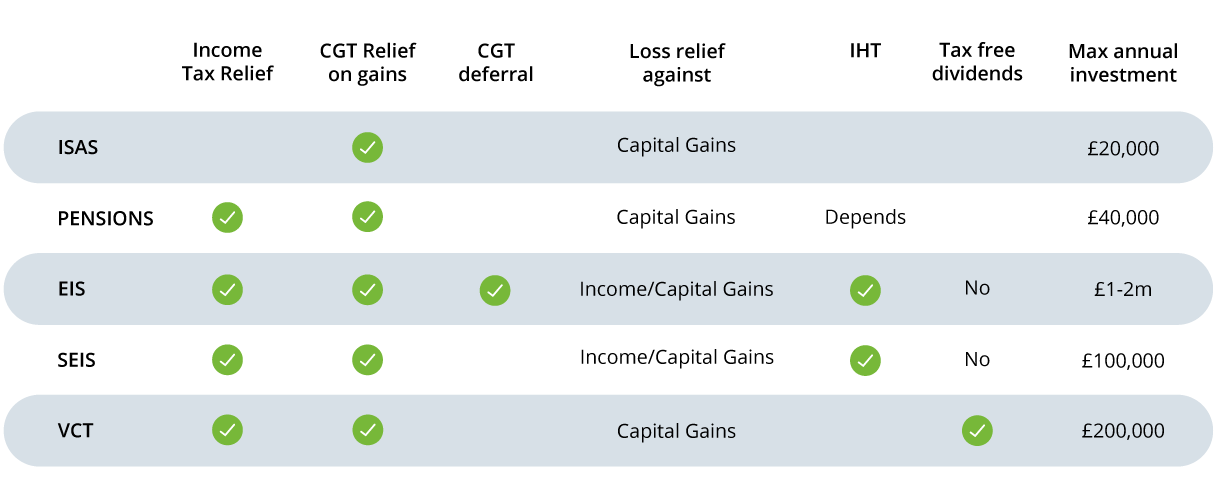What are tax-efficient investments?
Tax-efficient investments give investors tax relief on investments in qualifying companies or investment vehicles.
Many UK government-approved schemes offer investors tax relief. These reliefs range from capital gains tax (CGT) to loss releif and inheritance tax relief.
As with all investments, there are trade-offs when weighing up the pros and cons of each. Two rules to keep in mind when considering these, or any type of investment:
First, if it sounds too good to be true, it probably is. We’ll only be looking at government-approved schemes in our review.
Second, the more tax relief on offer, the riskier the investment class is likely to be. We’ll get into this later when we talk about the alternative investments that offer tax relief.
Below we’ll take you through the HMRC-approved tax-efficient vehicles and the various reliefs they offer. While you can’t avoid paying tax entirely, you can reduce the amount you pay while diversifying your portfolio and having an impact too.
The benefits of tax-efficient investments
Income tax relief
EIS, SEIS, and VCT investments allow you to reduce the income tax owed to the government by a percentage of the amount invested.
Capital gains tax relief
Some investments, including some ISAs, EIS and SEIS, do not incur taxes on the gains made by those investments when held for a defined period of time.
Capital gains tax deferral
Investors may defer paying capital gains tax on a gain invested through the Enterprise Investment Scheme (EIS).
Inheritance tax relief
Many alternative investments allow investors to take advantage of some form of inheritance tax relief. Investments held for a set number of years fall outside of the estate and are not subject to IHT.
Loss relief
Some tax-efficient investments allow investors to offset their losses against income tax. Typically losses may only be offset against capital gains.
Comparison of tax-efficient investments
The table below compares the different tax-efficient investments on the benefits they offer. We compare ISAs (Individual Savings Accounts), Pension Schemes, EIS (Enterprise Investment Scheme), SEIS (Seed Enterprise Investment Scheme) and VCT (Venture Capital Trust).

Mainstream tax efficient investments
Individual Savings Accounts (ISA)
ISAs provide tax-free savings on investments allowing the investor to maximise returns. ISAs shield the gains from income tax, capital gains tax, and tax on dividends. There are several types of ISA:
Stocks and Shares ISA: Allows investors to invest in listed stocks or funds.
Cash ISA: Earn interest on savings and not pay tax on the earnings.
Junior ISA: Savings parents make for children.
Lifetime ISA: For first-time buyers who must use their savings for the purchase of a home. The government contributes 25% of up to £4000 invested into the ISA each year.
Innovative finance ISA: Allows investors to invest through Peer-to-peer (P2P) lending platforms. This ISA is sometimes referred to as the IFISA.
Pension Schemes
Pensions are either self-managed, through a SIPP (self-invested personal pension), or managed by a fund manager.
Pensions allow for tax relief of 20% on the amount of any income you have paid 40% tax on and 25% on the amount of any income you have paid 45% tax on.
Alternative tax efficient investments
Alternative tax-efficient investments offer more generous tax reliefs than mainstream investments. This comes at the trade-off of an increased level of risk associated with the underlying investments.
Mainstream vehicles invest in large liquid stocks, funds, bonds or held in cash. Alternatives invest in startups, collectables (art, wine, vintage cars) or other illiquid assets. Below we outline a few of the alternatives available.
Investing in startups with EIS and SEIS
Early-stage investing is risky by nature. Startups must find a sustainable competitive edge to compete with incumbents. Shifts in markets and public opinion make it a harder task. Given that, It's unsurprising that nine out of ten startup fail.
Despite the odds, investors continue to back these small, enterprising companies seeking to change the world. For some, it's the thrill, for others, it's the generous tax reliefs. The EIS and SEIS tax reliefs are the envy of startup investors around the world.
The Enterprise Investment Scheme (EIS)
The Enterprise Investment Scheme (EIS) was launched in 1994 to encourage investments in small, high-risk companies in the UK. Each year approximately £2bn flows through the scheme into several startups. The scheme has done its job of encouraging individuals to invest in startups.
Investors receive tax relief on up to £1m per year of EIS investments - £2m if investing in knowledge-intensive companies.
Read more about the Enterprise Investment scheme by downloading our EIS Guide.
Income tax relief of 30% of your investment. This can be used in the year of investment or carried back one year.
Capital gains exemption on profits earned on shares held for a minimum of three years.
Loss relief, should the company you’ve invested in fail, equivalent to your tax bracket multiplied by your at-risk capital (the amount invested less income tax relief received).
Capital gains deferral on gains realised on the disposal of any asset which is reinvested in an EIS-qualifying company.
Inheritance tax exemption on shares held for a minimum of two years.

Please note: our office hours are weekdays, 9.30am - 5.30pm.